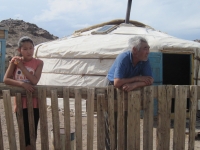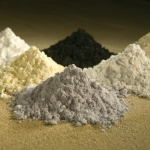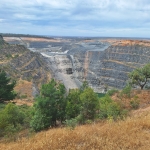Mongolian Nomadic Herders Worry About Impact of Rio Tinto's Gold Mine

Mongolian livestock herders are worried that a series of massive gold and copper mining projects will dry up scarce water reserves and exacerbate desertification in the delicate Gobi Desert when operations begin next year to tap one of the world's largest copper and gold deposits.
A landlocked country of 2.8 million caught between China and Russia, Mongolia is home to the first "cowboys" - nomadic herdsman. Even today, two out of five people in Mongolia still make their living herding livestock, and the same number live in poverty.
After the fall of the Soviet Union, Mongolia's major former trading partner, the government encouraged free market development and expansion of mining in the gold, copper and uranium-rich country, on the advice of the World Bank. Last year the country's economy grew 17 percent from mining alone - faster than any other in the world and twice as fast as China.
Eurasia Capital, a Hong Kong-based investment bank, estimates that Mongolia sits on $1.3 trillion worth of untapped mineral assets. They predict that the country's gross domestic product could swell from $5 billion to $30 billion by 2020, based on its mineral resources alone.
The biggest project to date - the $6 billion Oyu Tolgoi gold and copper mine ("Turquoise Hill" in Mongolian) - is now nearly ready to open. Located just 50 miles north of the Chinese border, it is expected to be one of the world's three largest mines when it reaches full production in 2018. Two thirds of Oyu Tolgoi is owned by Canadian-owned Turquoise Hill (formerly Ivanhoe Mines), which in turn is majority-owned by Rio Tinto, the world's largest private mining company, based in London.
"This is the biggest agreement in the history of the country by a magnitude of a thousand," Jim Dwyer, executive director of the Business Council of Mongolia, told the Global Mail in February.
Indeed, even while under construction Oyu Tolgoi accounted for 30 percent of Mongolia's current economy, according to the mine's spokesperson. Already thousands of young people in their 20s and 30s have flocked to the capitol, Ulan Bator, seeking jobs working for Oyu Tolgoi. The noveaux rich spend time at the new Irish pubs near the Louis Vuitton store and watch Hummers drive by alongside Soviet-era buses.
"When international investors make big decisions to employ their scarce capital, cutting-edge technology, management expertise, and marketing prowess, they look for responsible partners," Oyu Tolgoi's Australian CEO Cameron McRae, said. "Partners like Rio Tinto prefer to invest in countries when the government takes the long view, as we do."
But critics say that the large-scale mining operations have dire social and environmental costs.
"We don't need money from mining," Battsengel Lkhamdoorov, a 40-year-old former herder, told the New York Times. "What we need is water and land."
Sukhgerel Dugersuren, head of Oyu Tolgoi Watch, a Mongolian non-governmental organization that keeps tabs on the mine, says the agreement with Rio Tinto is a bad deal for Mongolia. Dugersuren said that the investment agreement the government signed with Rio Tinto is unfair and that World Bank leadership pushed too hard for the Mongolian government to sign on. She told the Bank Information Center in Washington DC that the World Bank extended "too much credit to Mongolia" in support of mining "without implementing compliance monitoring mechanisms or impact assessments."
Today, the Mongolian government owns just 34 percent of the mine under the deal that was signed with Rio Tinto in 2009. Mongolian members of parliament are now pressuring the government to push the mining companies to renegotiate for a majority 51 percent share but the company has refused - noting that the agreement only allows for the state to negotiate for a larger share after the project has been in operation for 30 years - and even then no more than 50 percent.
Even worse, the London Mining Network alleges that the Mongolian government signed the agreement "before a technical and economic feasibility study was accepted by the Mongolian government, as prescribed by law." Additionally, the London Mining Network notes that the mining company has failed to show that there is enough water for the 30 to 60-year project.
This is despite the fact that mining industries consume the largest part of the country's annual water consumption, says The RiverMovements, a Mongolian environmental group which points out that Oyu Tolgoi will use approximately 243 gallons of water a second.
Meanwhile nomadic herders, who comprise 40 percent of the country's population, will be forced to wander further to find water for their flocks, a 2011 United States Agency of International Development report said.
"(Oyu Tolgoi) does not understand the dynamics of herding and the need to follow the livestock to adequate pasture and water sources," the report stated. "It is economically and psychologically difficult for herder families to move from their traditional land."
Rio Tinto says it is committed to having a "zero impact on community water sources."
"The water source for Oyu Tolgoi is the Gunii Hooloi aquifer - a deep, non-drinkable water source that is separate from the shallow water sources used by households and animals," the company states on its website. "Oyu Tolgoi is only allowed to use approximately 20 per cent of the water from Gunii Hooloi, so the aquifer can never be exhausted. We do not need to take water from any other source."
But many local herders are skeptical.
"When we come to the well, we can see the level of the well water is 8 inches lower than it used to be," Mijiddorj Ayur, a 76-year-old who herds his camels near Oyu Tolgoi, told National Public Radio.
Oyu Tolgoi Watch believes that the country should invest instead in sustainable economic development that bolsters traditional livelihoods like cashmere production and organic beef ranching.
"If the same amount of credit was made available to developing world standards products and services from these sectors Mongolia could sit on its wealth until there is dire need to disturb the earth," Dugersuren said. "Unfortunately, this does not coincide with the interest of the World Bank to support Western industries to extract and sell minerals to China."
The government has made a major effort to ban mining in environmentally sensitive areas but ironically this has the heaviest economic impact on the 100,000 Mongolian self-employed miners rather than on Rio Tinto. By contrast, Oyu Tolgoi will employ about 3,500 workers when it is fully operational, according to the World Bank.
- 183 Environment



